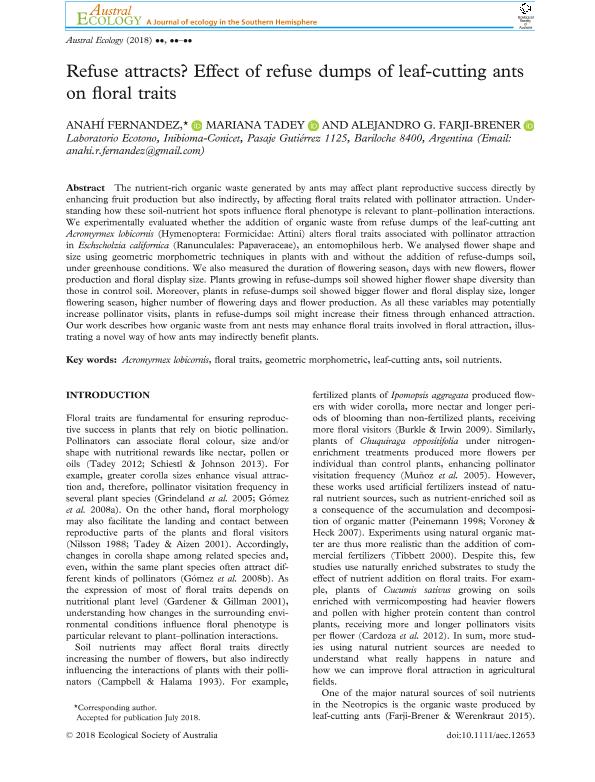Mostrar el registro sencillo del ítem
dc.contributor.author
Fernandez, Anahi Rocio

dc.contributor.author
Tadey, Mariana

dc.contributor.author
Farji Brener, Alejandro Gustavo

dc.date.available
2020-01-09T19:14:14Z
dc.date.issued
2019-02-13
dc.identifier.citation
Fernandez, Anahi Rocio; Tadey, Mariana; Farji Brener, Alejandro Gustavo; Refuse attracts? Effect of refuse dumps of leaf-cutting ants on floral traits; Wiley Blackwell Publishing, Inc; Austral Ecology; 44; 1; 13-2-2019; 70-77
dc.identifier.issn
1442-9985
dc.identifier.uri
http://hdl.handle.net/11336/94183
dc.description.abstract
The nutrient-rich organic waste generated by ants may affect plant reproductive success directly by enhancing fruit production but also indirectly, by affecting floral traits related with pollinator attraction. Understanding how these soil-nutrient hot spots influence floral phenotype is relevant to plant–pollination interactions. We experimentally evaluated whether the addition of organic waste from refuse dumps of the leaf-cutting ant Acromyrmex lobicornis (Hymenoptera: Formicidae: Attini) alters floral traits associated with pollinator attraction in Eschscholzia californica (Ranunculales: Papaveraceae), an entomophilous herb. We analysed flower shape and size using geometric morphometric techniques in plants with and without the addition of refuse-dumps soil, under greenhouse conditions. We also measured the duration of flowering season, days with new flowers, flower production and floral display size. Plants growing in refuse-dumps soil showed higher flower shape diversity than those in control soil. Moreover, plants in refuse-dumps soil showed bigger flower and floral display size, longer flowering season, higher number of flowering days and flower production. As all these variables may potentially increase pollinator visits, plants in refuse-dumps soil might increase their fitness through enhanced attraction. Our work describes how organic waste from ant nests may enhance floral traits involved in floral attraction, illustrating a novel way of how ants may indirectly benefit plants.
dc.format
application/pdf
dc.language.iso
eng
dc.publisher
Wiley Blackwell Publishing, Inc

dc.rights
info:eu-repo/semantics/openAccess
dc.rights.uri
https://creativecommons.org/licenses/by-nc-sa/2.5/ar/
dc.subject
ACROMYRMEX LOBICORNIS
dc.subject
FLORAL TRAITS
dc.subject
GEOMETRIC MORPHOMETRIC
dc.subject
LEAF-CUTTING ANTS
dc.subject
SOIL NUTRIENTS
dc.subject.classification
Ecología

dc.subject.classification
Ciencias Biológicas

dc.subject.classification
CIENCIAS NATURALES Y EXACTAS

dc.title
Refuse attracts? Effect of refuse dumps of leaf-cutting ants on floral traits
dc.type
info:eu-repo/semantics/article
dc.type
info:ar-repo/semantics/artículo
dc.type
info:eu-repo/semantics/publishedVersion
dc.date.updated
2019-10-10T13:58:05Z
dc.journal.volume
44
dc.journal.number
1
dc.journal.pagination
70-77
dc.journal.pais
Reino Unido

dc.journal.ciudad
Londres
dc.description.fil
Fil: Fernandez, Anahi Rocio. Consejo Nacional de Investigaciones Científicas y Técnicas. Centro Científico Tecnológico Conicet - Patagonia Norte. Instituto de Investigaciones en Biodiversidad y Medioambiente. Universidad Nacional del Comahue. Centro Regional Universidad Bariloche. Instituto de Investigaciones en Biodiversidad y Medioambiente; Argentina. Universidad Nacional del Comahue. Centro Regional Universitario Bariloche. Laboratorio de Ecotono; Argentina
dc.description.fil
Fil: Tadey, Mariana. Consejo Nacional de Investigaciones Científicas y Técnicas. Centro Científico Tecnológico Conicet - Patagonia Norte. Instituto de Investigaciones en Biodiversidad y Medioambiente. Universidad Nacional del Comahue. Centro Regional Universidad Bariloche. Instituto de Investigaciones en Biodiversidad y Medioambiente; Argentina. Universidad Nacional del Comahue. Centro Regional Universitario Bariloche. Laboratorio de Ecotono; Argentina
dc.description.fil
Fil: Farji Brener, Alejandro Gustavo. Consejo Nacional de Investigaciones Científicas y Técnicas. Centro Científico Tecnológico Conicet - Patagonia Norte. Instituto de Investigaciones en Biodiversidad y Medioambiente. Universidad Nacional del Comahue. Centro Regional Universidad Bariloche. Instituto de Investigaciones en Biodiversidad y Medioambiente; Argentina. Universidad Nacional del Comahue. Centro Regional Universitario Bariloche. Laboratorio de Ecotono; Argentina
dc.journal.title
Austral Ecology

dc.relation.alternativeid
info:eu-repo/semantics/altIdentifier/doi/http://dx.doi.org/10.1111/aec.12653
dc.relation.alternativeid
info:eu-repo/semantics/altIdentifier/url/https://onlinelibrary.wiley.com/doi/full/10.1111/aec.12653
Archivos asociados
